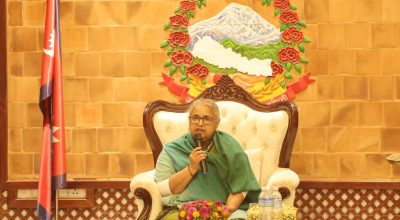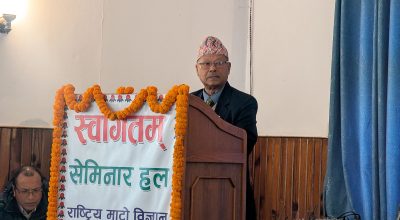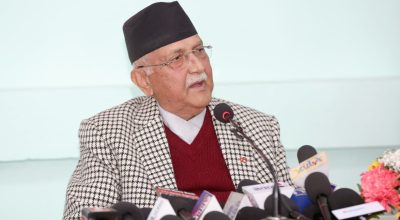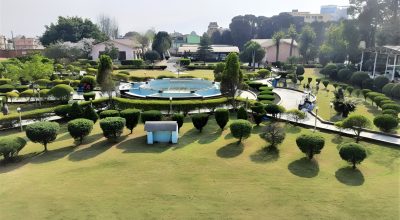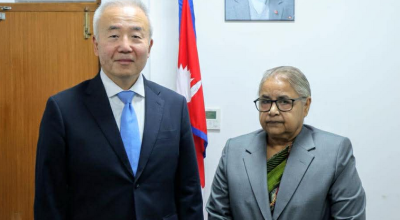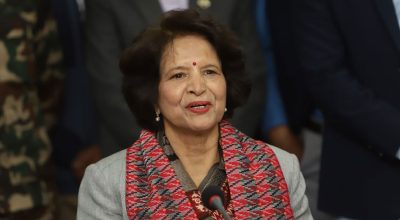
Kathmandu, Feb 27: Nepal is moving towards self-sufficiency in allopathic medicine. Thirty years ago Nepali medicine was seen in a negligible amount in the market, but now it has increased significantly. As a result, Nepali medicines have started reaching a share of around 50 percent in the country’s pharmaceutical market.
According to Mahesh Pradhan, President of Association of Pharmaceutical Producers of Nepal (APON), Nepali medicine, which had only 10% share 20 years ago, has now reached about 50%. He said that the market share of medicine is increasing every year. Currently, the Nepali market has a drug turnover of 90 billion. Out of that, Nepali medicine’s share is about Rs 34 billion. A total of 86 modern industries and 55 ayurvedic industries are registered in the Department of Drug Administration.
In Nepal, since 2018 BS, the production of medicine has started with the production of vaccine by the Animal Diagnostic Laboratory. In 2027 BS, rabies vaccine was produced for animal and human use. In the case of chemical medicine, the establishment of Chemidrug Industries Pvt Ltd in 2026 BS, the establishment of Nepal Aushadhi Limited in 2029, the introduction of Drug Act in 2035 BS, and the establishment of the Department of Drug Administration in 2036 BS, the development of the pharmaceutical industry has come after 2046 BS.
Nepali pharmaceutical industries have been producing 700 to 750 types of molecules, and that is nearly 70 percent of Nepali market share. It can produce nearly five thousand different types of medicines using those molecules. These success trend have greatly helped towards self-reliant in medicine inside the country, says Santosh Baral, Vice President of APON. “Twenty years ago, there was only a 10 percent share in the Nepali pharmaceutical market,” he said, “Now we have started to make the pharmaceutical industry independent through our own efforts and investments.”
On the other hand, Nepal Aushadhi Limited also manufactures medicines from the government. Kailash Kumar Paneru, General Manager of Nepal Aushadhi, says that currently only eight types of medicine are produced. “Earlier, we used to produce up to 140 types of medicines. We had to close down the factory for four years,” he said. “Now we have to reduce to eight types of medicine.” He said that the company is producing paracetamol and Jeevanjal.
Machines, not operating at full capacity
Machines of Nepali pharmaceutical industry are not fully operational. Some pharmaceutical industries are operating 80 percent of their machines. Even though the country has the capacity to produce 70 to 80 percent of medicines, the industry has not been fully operational because the government does not purchase Nepali medicines, says Pradhan. “There are industries in Nepal that are only 30 to 35 percent operational,” he said, “Due to the industry not being fully operational, sufficient quantity of medicine has not been produced.”
He said that there is a need for the state to promote the Nepali pharmaceutical industry in the country.
Government can buy Nepali medicine
APON says that the government should buy medicines produced in Nepal to be used in government hospitals. Pradhan, president of the Association for the Development of Nepali Industry, says that even if only central, provincial and local government hospitals, Nepali Army and Nepal Police hospitals will buy medicines produced in Nepal.
“The government should buy the medicines we have produced. We produce as much medicine as possible so that the country does not lack medicine,” he said. “After that, the government should also stop the import of medicine from outside. If the domestic medicine industry has produced any medicine, do not import that medicine.”
Price adjustment
APON’s Vice President Baral says that drug prices have not been adjusted for 16 years. Although the prices were adjusted for the first time in 2062 BS and for the second time in 2072 BS, the prices of medicines have not been adjusted according to time.
He says that the price of medicines should be revised at least once a year to make the industry work and to give Nepali medicine a chance to serve the country. “In the year 2062 BS, the prices of some medicines were fixed. After that, the prices of medicines have not been adjusted,” he said.
“In international level, the prices of raw materials have been increasing. Salary of employees, bank interest is also increasing. We cannot sell medicines at 16-year-old prices.”
India is a country that manufactures drugs at the cheapest price in the world, but the Nepali pharmaceutical industry is forced to sell drugs at a cheaper price than India.
Dhakal, Director General of the DDA, says that the prices of Nepali medicines should also be adjusted according to the international market.





